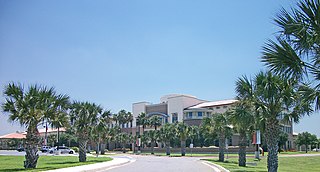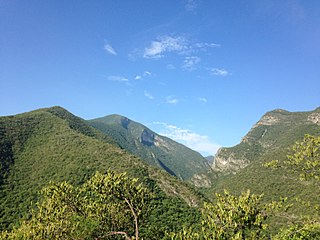
The Rio Grande is one of the principal rivers in the southwestern United States and northern Mexico. The Rio Grande begins in south-central Colorado in the United States and flows to the Gulf of Mexico. After passing through the length of New Mexico along the way, it forms part of the Mexico–United States border. According to the International Boundary and Water Commission, its total length was 1,896 miles (3,051 km) in the late 1980s, though course shifts occasionally result in length changes. Depending on how it is measured, the Rio Grande is either the fourth- or fifth-longest river system in North America.

Harlingen is a city in Cameron County in the central region of the Rio Grande Valley of the southern part of the U.S. state of Texas, about 30 miles (48 km) from the coast of the Gulf of Mexico. The city covers more than 40 square miles (104 km2) and is the second-largest city in Cameron County, as well as the fourth-largest in the Rio Grande Valley. As of the 2010 census, the city had a population of 64,849, for a growth rate of 12.5% since the 2000 census.

Santa Fe de Nuevo México was a Kingdom of the Spanish Empire and New Spain, and later a territory of independent Mexico. The first capital was San Juan de los Caballeros from 1598 until 1610, and from 1610 onward the capital was La Villa Real de la Santa Fe de San Francisco de Asís. The name "New Mexico", the capital in Santa Fe, the government building, militia or citizen-soldiers (vecinos), and rule of law were retained when the New Mexico Territory, later the U.S. State of New Mexico, became a part of the United States. The New Mexican citizenry, primarily consisting of Hispano, Pueblo, Navajo, Apache, and Comanche peoples, became citizens of the United States as a result of the Treaty of Guadalupe Hidalgo.

Rio Grande City is a city in and the county seat of Starr County, Texas. The population was 13,834 at the time of the 2010 census. The city is 41 miles (66 km) west of McAllen. The city also holds the March record high for the United States at 108 °F (42 °C). The city is connected to Camargo, Tamaulipas, via the Rio Grande City–Camargo International Bridge. The city is situated within the Rio Grande Valley.

Big Bend National Park is an American national park located in West Texas, bordering Mexico. The park has national significance as the largest protected area of Chihuahuan Desert topography and ecology in the United States, and was named after a large bend in the Rio Grande/Río Bravo. The park protects more than 1,200 species of plants, more than 450 species of birds, 56 species of reptiles, and 75 species of mammals. Additional park activities include scenic drives, programs led by Big Bend park rangers, and stargazing.
Lipan Apache are Southern Athabaskan (Apachean) Native Americans whose traditional territory includes present-day US states of Texas, New Mexico, and Colorado, and the northern Mexican states of Chihuahua, Nuevo León, Coahuila, and Tamaulipas, prior to the 17th century.

In Texas, the Río Grande Valley, commonly known locally as The Valley, is a transborder socio-cultural region located in a floodplain draining into the Rio Grande near its mouth. The region includes the southernmost tip of South Texas and a portion of northern Tamaulipas, Mexico. It consists of the Brownsville, Harlingen, Weslaco, Pharr, McAllen, Edinburg, Mission, San Juan, and Rio Grande City metropolitan areas in the United States and the Matamoros, Río Bravo, and Reynosa metropolitan areas in Mexico. These cities are surrounded by many small neighborhoods or colonias. The area is generally bilingual in English and Spanish with a fair amount of Spanglish due to the diverse history of the region. There is a large seasonal influx of "winter Texans" — Texans who come down from the north for the winter and then go back up north before summer arrives.

South Texas is a region of the U.S. state of Texas that lies roughly south of—and including—San Antonio. The southern and western boundary is the Rio Grande, and to the east it is the Gulf of Mexico. The population of this region is about 4.96 million according to the 2017 census estimates. The southern portion of this region is often referred to as the Rio Grande Valley. The eastern portion along the Gulf of Mexico is also referred to as the Coastal Bend.

The Sierra Madre Oriental is a mountain range in northeastern Mexico. The Sierra Madre Oriental is part of the American Cordillera, a chain of mountain ranges (cordillera) that consists of an almost continuous sequence of mountain ranges that form the western "backbone" of North America, Central America, South America, and Antarctica.

The Republic of the Rio Grande was an independent nation that insurgents fighting against the Centralist Republic of Mexico sought to establish in northern Mexico. The Republic of the Rio Grande was just one of a series of independence movements in Mexico under the unitary government dominated by Santa Anna, including the Republic of Texas, the Republic of Zacatecas, and the Republic of Yucatán. The rebellion lasted from 17 January to 6 November 1840.
The phantom shiner is an extinct species of fish. It was once endemic to the Rio Grande basin and ranged from central New Mexico to southernmost Texas and adjacent Tamaulipas. It was once found in the warm water reaches of the Rio Grande, though never particularly abundant. The species was last collected on 28 July 1975, in Tamaulipas, Mexico, 4.0 km below Ciudad Diaz Ordaz. Subsequent attempts to collect the phantom shiner from 1977 to 1994 were unsuccessful and it has been presumed extinct as of 1996.

The Texas Mexican Railway is a railroad that operates as a subsidiary of the Kansas City Southern Railway in Texas. It is often referred to as the Tex-Mex, or TexMex Railway.

Amistad Reservoir is a reservoir on the Rio Grande at its confluence with the Devils River 12 miles (19 km) northwest of Del Rio, Texas. The lake is bounded by Val Verde County on the United States side of the international border and by the state of Coahuila on the Mexican side of the border; the American shoreline forms the Amistad National Recreation Area. The reservoir was formed in 1969 by the construction of Amistad Dam. The dam and lake are managed jointly by the governments of the United States and Mexico through the International Boundary and Water Commission. The name of the dam and lake is the Spanish word for "friendship". The reservoir is also known as Lake Amistad.

The Rio Grande leopard frog is a species of aquatic frog native to the southern United States in Texas and New Mexico, and south through Mexico and Central America. It is also sometimes referred to as the Mexican leopard frog. The epithet berlandieri is in honor of the naturalist Jean Louis Berlandier, who worked for the Mexican government on one of the first biological surveys of Texas.

The Rio Grande cutthroat trout, a member of the family Salmonidae, is found in northern New Mexico and southern Colorado in tributaries of the Rio Grande.,

The Rio Grande cooter is a species of turtle in the family Emydidae. The species is native to northeastern Mexico and the adjacent southwestern United States.

The Tamaulipan mezquital is a deserts and xeric shrublands ecoregion in the southern United States and northeastern Mexico. It covers an area of 141,500 km2 (54,600 sq mi), encompassing a portion of the Gulf Coastal Plain in southern Texas, northern Tamaulipas, northeastern Coahuila, and part of Nuevo León.

Big Bend Ranch State Park is a 311,000-acre (126,000 ha) state park located on the Rio Grande in Brewster and Presidio counties, Texas. It is the largest state park in Texas. The closest major town is Presidio, Texas, where the state park's head office is located.

The Lower Rio Grande Valley National Wildlife Refuge is a 90,788-acre (367.41 km2) National Wildlife Refuge located in the Lower Rio Grande Valley region of southern Texas.
Texas v. New Mexico and Colorado, 141-orig, ___ U.S. ___ (2018), was a Supreme Court case argued and decided during the 2017 term of the Supreme Court of the United States. The case involved an interstate dispute regarding New Mexico's compliance with the Rio Grande Compact of 1938, an agreement which established a plan for equitable apportionment of the water in the Rio Grande Basin among the states of Colorado, New Mexico, and Texas. The Court considered the question of whether the US federal government had a legal right to join litigation against New Mexico; the Court ruled that the federal government was within its rights when it did so.

















